
views
Grooming Your Horse
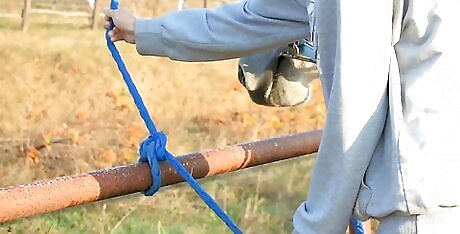
Secure your horse. Although some horses are trained well enough to stand still while grooming, many will feel the natural need to move their feet and shift around. Keep your horse in place by tying the lead rope above the height of his withers. Use a quick-release knot, securing him to a post, or have a friend or colleague hold the rope. If you're tying your horse to a ring or post, always use a quick-release knot. A horse that spooks while he is tied often tries to escape by pulling back against the rope with all of his force. This is dangerous for both you and the horse. He may break his neck and you may be seriously injured. You may wish to keep a Marlinspike in your grooming kit, which is a tool that can loosen too-tight knots or cut a rope in an emergency.
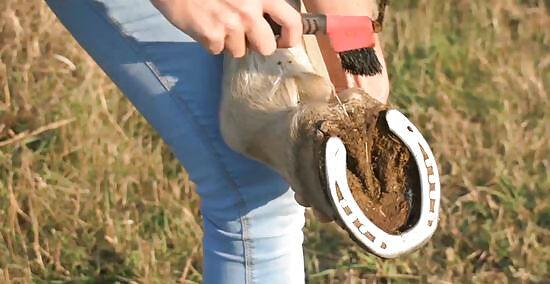
Pick your horse's hooves. To pick up her foot, run your hand down her leg and gently squeeze her tendon. If she doesn't lift her foot, lean against her shoulder, squeeze her leg, and use your other hand to quickly grab your horse's hoof. Using a hoof pick, start at the heel of the foot and pick forward to the toe, carefully removing all rocks, dirt and debris. Make sure to clean the grooves on either side of the frog, the V-shaped part of the hoof. You should neither pick the horse's frog or dig deeply into the grooves. If the frog is unhealthy, that is, it is very black, squishy, soft and foul-smelling, be very careful with the hoof pick and have your farrier or veterinarian advise you. By picking out your horse's feet, you can help prevent lameness by removing stones or foreign objects like a nail or screw that could pierce the frog or cause bruising. Picking the hooves out before riding is essential, especially if your horse is wearing shoes. A shod foot does not clean itself when a horse moves, so cleaning can make walking much more comfortable for your horse. Picking your horse's feet can also help remove and prevent thrush, a sticky black fungus that develops around the frog. The best times to pick your horse's feet are before and after a ride.
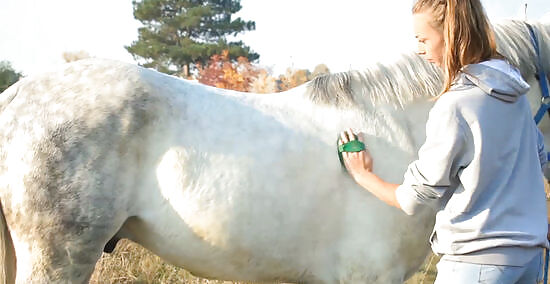
Use a curry comb to remove loose hair from the horse. Rubber curry combs are made to loosen up dirt, mud, and bits of things caught in your horse's coat. Currying should always be performed before brushing for the best results. Use the curry in vigorous, small circular motions over the horse's muscles, and be extremely careful on bony areas like the face, spine, and legs. Most horses enjoy currying, since it is kind of like a massage. On one side of the horse, work your way from the neck, to the barrel, and all the way to the rump. Then, repeat on the other side of the horse. If your horse is a riding horse, remember to to brush well in your horse's girth area. The curry comb should be rubbed in a circular motion in the direction opposite of the hair growth. This will pull up loose hairs and dirt that otherwise would just be brushed over. If you find “itchy spots” on your horse, he may make a funny face, pushing his nose away from his lips, or he may even try to groom you. Be careful; if he wiggles his nose on you, he may also try to nip you just the same way horses groom each other. A horse doesn’t understand that grooming you could hurt you, but your skin is much thinner than a horse's. If he tries to groom you, just push his nose away and know you found an “itchy spot” and he really enjoyed that good scratch.
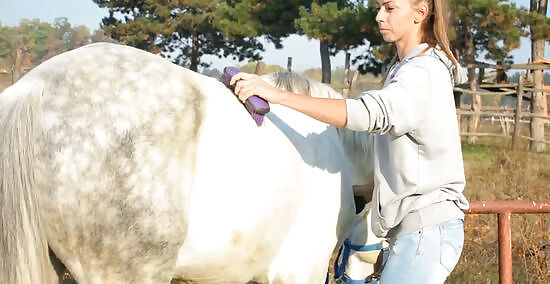
Use a dandy brush (also called the hard brush). A dandy brush is a hard-bristled brush used to take off the dirt and hair brought out by the curry comb. Brush in short, straight, flicking motions to allow the bristles to get all the way through the coat and whisk the dirt out. Start at the neck and work towards the tail. It's not recommended to use a hard brush on the horse's legs, as they are much more sensitive than the body. The legs are bony and narrow and it is uncomfortable for the horse if brushed too hard with the dandy brush. Do not use on the face, ears, mane, tail, legs, or any clipped area, as this can cause the horse to be in immediate discomfort. If necessary, use a soft cloth or sponge on any sensitive parts of the horse where the dandy seems to bother or irritate her.
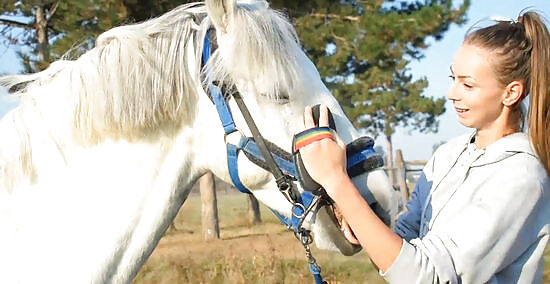
Clean up with a soft brush (also known as the body brush). The soft brush, as its name suggests, can be used on all areas of the horse as a result of its texture. You should still be careful and gentle around the face and around the eyes, ears, and muzzle. The soft brush removes any remaining surface dust and hair. Finish up your body-grooming by brushing down the entire body, including sensitive areas like the face and legs. If you want to use a separate brush for the face, use a face brush. They are designed for brushing horses' faces. They look like miniature soft brushes and are much easier to fit on a horse's face.
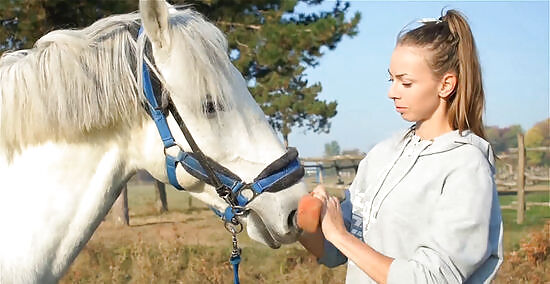
Clean the horse's face. Take a damp sponge or washcloth, wipe your horse's eyes, and clean out his nose. Use a different sponge/cloth/wipe for the dock area (under the tail). Because these areas are constantly moist, dirt and mucus build up and need to be cleaned out. Always remember to be gentle when doing this; these areas are sensitive. Use different brushes, sponges, and cloths for each horse if you are grooming multiple horses. Infection and skin fungus, like ringworm, can be spread by sharing grooming tools.
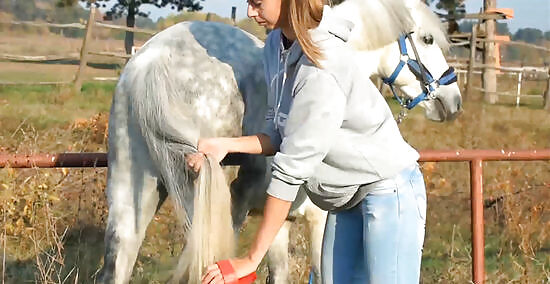
Brush out the mane and tail. Use a wide-bristled mane comb or brush to get tangles out of the mane and tail. Before you start, use your fingers to separate the hairs caught in large tangles. Hold the whole tail/large section of mane in one hand (to avoid tugging) and brush it out with the other. Continue taking small pieces from the side of the tail until you have brushed the whole tail. When brushing the tail, stand to the side of the horse. This way, if the horse kicks out, you are in a safer position and less likely to be hurt. Make sure to talk to the horse and keep your hand on the horse to keep her attention on you. If you want to use a hair product, use natural mane/tail sprays that are all-natural rather than silicone-based. Spray it on and work it in; other than helping with the detangling, it will moisturize and make the hair look shiny.

If it is summer or hot out, you may want to spray the horse with fly spray. Flies can be a major irritant to your horse. They can build up around the face, spread infections, and large flies, called horse flies, can bite and cause pain. The flies will most likely annoy you, too. Just spray the solution on the horse, being careful to avoid the face. There are both natural and chemical fly sprays on the market.
Staying Safe While Grooming
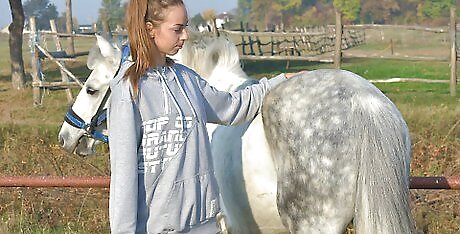
Never stand directly behind your horse while grooming. Stand always to one side of the legs. If he begins kicking or moving, you will not be in danger of getting kicked. If you must be behind his back end or hind legs, keep a hand firmly touching him and speak to him so knows you are there. You can also cross behind him by simply crossing well beyond the reach of his legs. Don't ever try to cross in front of a horse. You can get tangled in his rope, trip, or be crushed or kicked if he jumps or moves forward.
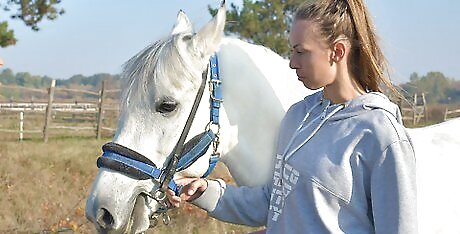
Approach your horse at an angle. Your horse has blind spots directly in front of and behind her. To avoid surprising her, make sure you approach from an angle or the side so she can see you, and announce your presence in a calm voice.

Move calmly and deliberately. Your horse will be reassured by calm, slow, deliberate movements. This also gives you a chance to watch for his reaction — if your horse shows signs of agitation when you touch a specific spot, you know to be more gentle or leave that spot alone.
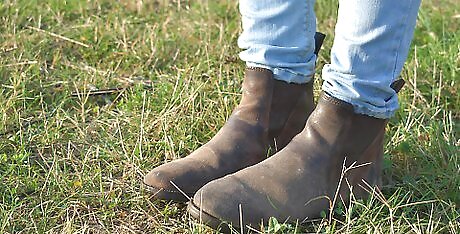
Wear the proper shoes. Your horse may accidentally step on your foot, and if you are barefoot or wearing sneakers or sandals, your foot will get crushed (horses generally weigh over 1,000 pounds). Wear sturdy boots that will protect your toes.

Be ready to move. Your horse has the nature and speed of any prey animal when startled or frightened, and you need to be ready to get out of the way if she gets scared. Sitting, kneeling, or lingering around your horse's feet may not only make her nervous, it may make it more difficult for you to move to safety. Instead, you can crouch, squat, or bend over if you need to get low on your horse's body.




















Comments
0 comment